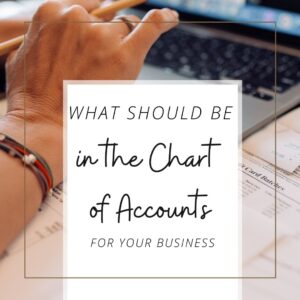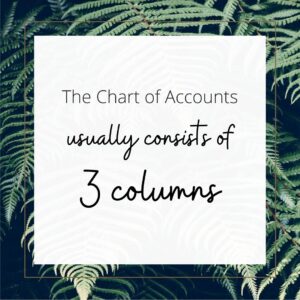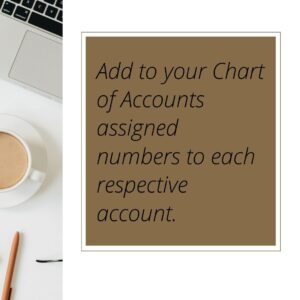What should be in the Chart of Accounts for your Business?

Whether you already own a business or are looking to create one, the term “chart of accounts” is one you should be familiar with. While there’s no shame in not knowing much about it (we all have our strengths and passions, right?), it is vital to understand this basic and necessary aspect to your business’ finances. Read on to see what should be in the chart of accounts
There’s no special sauce or secret formula when setting up a Chart of Accounts (COA) for your business. Simply make a list of the various accounts that apply to your business. Don’t panic if you don’t know each of these off the top of your head. It’s very easy to add to the Chart of Accounts at any time and as accounts change over the lifetime of your business’ growth.

First things first, types of accounts.
Balance Sheet Accounts:
Assets – things that the business owns and has possession of. For example, bank accounts, inventory, furniture, fixtures, equipment.
Liabilities – things that the business owes to someone else. For example, credit card balance, tips collected from customers and due to employees, gift card money collected, tax money collected and due to the city / state, loans, etc.
Equity – typically money that the owner of the business put in to start the business.
Income Statement (aka Profit and Loss Statement) Accounts:
Revenue.
This area is important to be detailed but broad. For example, if you own a restaurant don’t categorize all your income into “Food and Beverage”. Instead you will want to categorize by meal period (breakfast, lunch and dinner) so that you can see which meal periods you earn the most money. Or maybe you want to see the difference between food and beverage sales. Or maybe you want to know if the buffet makes more money than a la carte.
These details are up to you but important to decide ahead of time. Also, be sure any items that will be eventually paid back out are not accounted for here. For example you collect tax and tip in your restaurant but you won’t keep it. It’s paid back out to your employees and the state. This is not recorded as revenue but instead should be a liability on the balance sheet. Do this wrong and you may overstate your revenue.
Cost of Goods Sold (COGS)
This is the area where you will record all the items you sell. In the restaurant example it would typically include food and beverage items. This would not include the plates you serve them on or the utensils used to eat with. Those are operating expenses.
Payroll, Salary and Wages.
This area you will track all items you pay to run your business (pro tip: only add the business owner salary if you are paying through payroll. Otherwise it goes under owner equity). Staff that you pay as employees (issue W2) or as contractors (issue 1099), health insurance, employer tax, bonus, vacation, sick days, should all be categorized in this area. The thing most people miss here is to gross up the salaries and wages and move the employee tax portion to the liability section. Like tips, employee withheld taxes will be paid to the government. Do this wrong and you may understate your expense.
Operating Expense.
This is everything that does not fit in the above mentioned categories. From office supplies, to software, plates, napkins, menus, paper products and certain furniture (ask your account about this as some can be considered assets).

One thing you could add to your Chart of Accounts are assigned numbers to each respective account. This can help differentiate between them for various charges. If your company is using a computerized system (we are big fans on QuickBooks), the computer automatically assigns the account number. Otherwise, you can opt for your own numbering system.
The most common number system you may see in automated software or even in other companies looks like the below
- Asset accounts: 1000 to 1999
- Liability accounts: 2000 to 2999
- Equity accounts: 3000 to 3999
- Sales 4000 to 4999
- Cost of Goods Sold accounts: 5000 to 5999
- Payroll and Labor Expenses 6000 to 6999
- Operating Expenses 7000 to 7999
This numbering system matches the one used by computerized accounting systems, making it easy for a company to transition if at some future time you decide to automate your books using a computerized accounting system.
The sample Chart of Accounts, shown, was developed using QuickBooks (source here). You can see a few accounts that are unique to the business, such as Cooking Supplies, and other accounts that are common only to retail business, such as Cash Discrepancies and Merchant Fees.
Why Is It Important to Have a Chart of Accounts?
The goal of implementing and maintaining a good Chart of Accounts is to categorize information in the clearest and most informative manner. This way, information can be accessed quickly and easily from the Chart itself.
The financial insights you can gain from your Chart of Accounts allows businesses to determine reasonable growth plans, discern when it’s time to seek additional investments, and gain a 30,000 foot view of how the business is performing overall. When time comes to locate invoices from years past or exact dollar amounts from specific transactions, you’ll find the Chart of Accounts helps greatly.
How to Use a Chart of Accounts
Every time you or your team take note of a business transaction, it should be annotated in your Chart of Accounts. From income to office expenses. So, how does staff know which account to record it in? Typically, there are different financial statements that each account corresponds to: the balance sheet and the income statement.
A balance sheet shows the overall health of your company. It tracks what assets your business owns, any liabilities like what you still owe, and the difference for paying off any financial obligations, known as, owner’s equity. These allow you to assess in a glance where your business stands so you can make educated decisions regarding the financial health and risks of your business’ bottom line.
When you work with us, we will recommend different categories for your Chart of Accounts. This is to make filing and reviewing as simple as possible. This saves you time and money – two resources every business owner knows is priceless! An example of just some types of categories we would recommend (industry-specific, of course) are as follows:
Banking: Checking and Savings accounts
Assets: Accounts Receivable and Prepayments
Fixed Assets: Office equipment, company vehicles
Liabilities: Accounts Payable and Wages
Credit Cards: Visa, MC, Discover, etc.
Equity: Retained Earnings
Expenses: Insurance, Fees for Subscriptions and Software, Meals/Entertainment
A well-run business is dependent upon a well-maintained Chart of Accounts. To make it easier to quickly see where your company’s finances are going and how you’re doing year-after-year, feel free to request a free consultation with us at Two Sense Consulting, LLC. We can help you keep track of your accounts with time-saving and money-saving practices!







